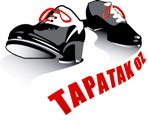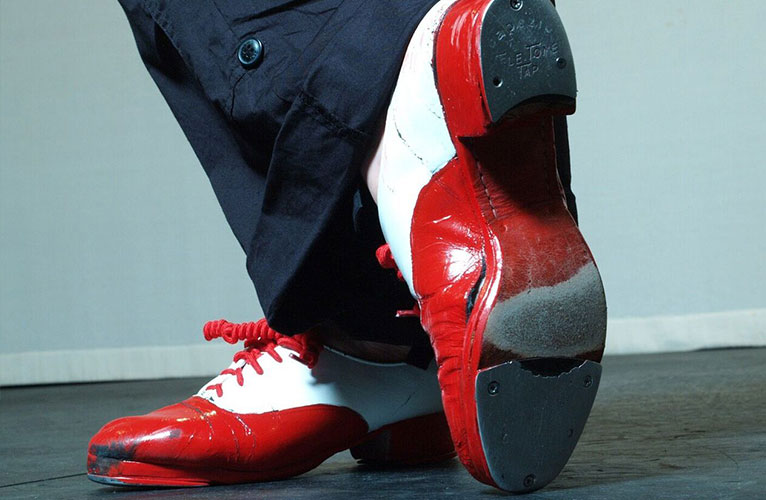As every tap dancer would know – tap shoes can be quite difficult to find, fit, maintain and wear in! And there are so many different types of tap shoes and taps available that deciding on a pair can be quite daunting. So let’s have a look at all these things.
Firstly, if you are studying tap dance with a dance school, check with your teacher to find out which style and colour of tap shoe he or she recommends. Often your teacher will have a preference and it is important that you adhere to this, as when you are dancing in a group for performance or competition, it is imperative that you all have the same style and colour of shoe so the group members all look the same. This adds polish and cohesion to the look of the group.
There are lots of funky looking tap shoes out there, but unless you are prepared to buy 2 pairs of shoes (which can be very expensive) make sure you have the shoe required by your particular dance school or teacher, or you could find yourself with a pair of shoes that looks great, but that you can not use in class.
OK – now that we have that out of the way, let’s take a look at the great debate: rubbers or no rubbers! The number of times students have asked me if I prefer to have rubbers on my shoes is countless and the answer is very simple. This is a personal choice. It is like asking if you prefer vanilla or chocolate ice cream. There is no right or wrong answer here.
If you put 100 professional tap dancers in a row, you would no doubt get a range of answers to this question. Some dancers like the feel and security of the rubbers on their tap shoes, but many others feel it dampens their sound and ability to spin and slide around when they tap. So this is a decision that you need to make for yourself. Just go with what feels right for you when you are tapping.
Another age old question when it comes to tap shoes is whether or not to loosen the screws to get a better sound. As I once heard a wise old tap master say “a great tapper never blames his shoes for his tapping or sound. A great tapper can make a pair of sneakers sound good”…….and there is an element of truth to that. Of course a well fitting pair of good quality shoes is always of great benefit but often times improving your technique and energy level when you tap will loosen your screws naturally and you will end up with a great sound!
If your screws are really tight, then loosen them the tiniest little bit. But then give the shoes a good work out so they mold into your foot and you will be on your way. There should be creases in the front of your tap shoe – where they bend when you are on the balls of your feet – and if there are not any creases there, then you may need to put them on and do a lot of marching on the balls of your feet with a good amount of energy to wear them in. But be patient – like any pair of new shoes they will take a little time to feel comfy – which brings me to my next point – BLISTERS!
As they say – prevention is better than cure – especially when it comes to blisters. The only way to avoid these with a new pair of shoes is to wear heaps of bandaids for the first few times you have the new shoes on. The new gel bandaids are great with tap shoes and I have avoided many a sore heel using these. So always be prepared. If you know your shoes rub on your heels, have some sort of bandage ready to go! Then happy days – no blisters!
So now we have a great pair of shoes that fit well, but the screws keep falling out all over the place. This is the tap dancers constant source of aggravation, but there is a way around it. The old ‘matchstick in the hole trick’!! But first make sure you ask an adult to assist you before you touch any matches!
I have found that the best way to keep my screws in, is to put the end of a matchstick (not the phosphorous red end – the other end ) into the offending hole where the screw usually fits. You will see that the hole is probably now too big for the screw, so putting the small slither of wood into the hole fills up this space so the screw has something to screw into…….so simple! Break off the match so the end is left in the hole, add some super glue to the tip of the screw and replace! Magic – the screw should be secure for years to come!
Now one final question I am often asked. Boots, tap sneakers, lace ups, high heels, low heels…….which is best! Again this is all personal preference. So try a few different types of shoe and choose what suits you. I am a traditionalist and like a good leather shoe with a low heel, as I like the way they add a lot of colour to the sound in my tapping. The heels on these shoes give great accent to your beats and the leather upper sole gives your foot a lot of flexibility and a connection to the floor that allows you to give your tapping a lot of light and shade.
But once again this is a personal choice! So find the shoe that fits you best and allows you to bring out the best sounds in your footwork. But remember – the sounds that come from the ball taps and the heel taps of your shoes should sound different. The front tap should be higher pitched with a bright sound and the heel tap lower pitched with a deep, heavy accent. If your tap shoes or taps don’t bring out this differentiation in your sound, then you may want to try something else.
And finally……..wearing tap shoes that are too big and do not fit snuggly to your heels should always be avoided. Firstly you will not be able to tap properly as the heels of the shoes will continually drop to the floor and muddy the sound. Secondly, it is also quite dangerous as your foot may go one way and the shoe another and this could lead to a terrible injury and damage to your ankles! So be careful when fitting your tap shoes!
So – there are a few tips to help you find a good pair of tap shoes and maintain them. And for heaps of great steps, exercises, canons and routines check out my tap syllabus at www.tapatak-oz.com
Till next time
Happy Tapping
Christine


